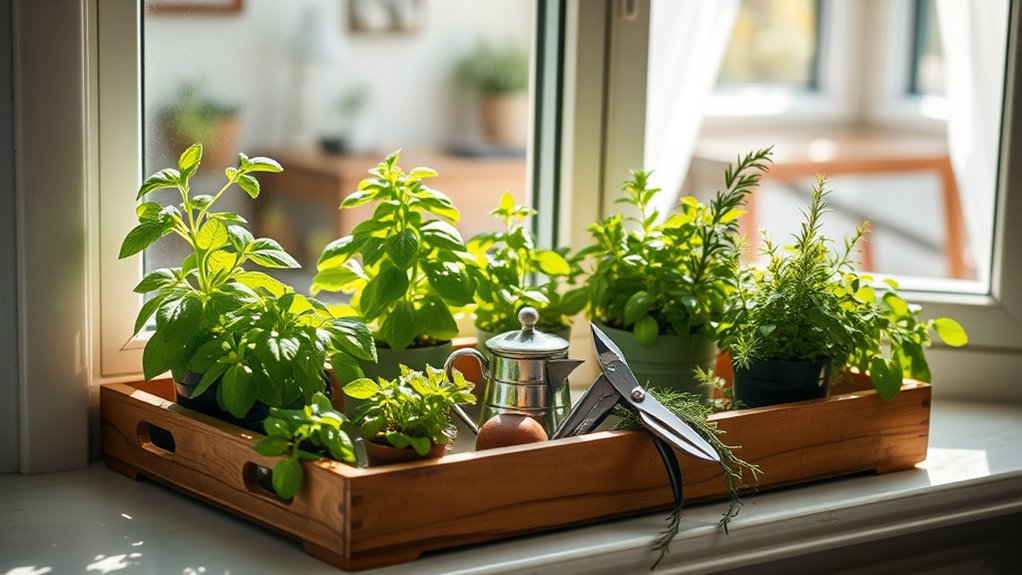How to Start an Indoor Herb Garden Without a Green Thumb
Starting an indoor herb garden might seem daunting, like trying to navigate a maze blindfolded. However, with the right approach, you can cultivate fresh herbs effortlessly, even if your gardening skills are minimal. You’ll need to consider factors like herb selection, container choice, and light requirements to ensure success. So, what are the essential steps to transform your kitchen into a thriving herb oasis? Let’s explore the fundamentals that will set you on the right path.
Choosing the Right Herbs for Beginners
When starting your indoor herb garden, which herbs should you choose to ensure success?
For an easy herb garden, opt for herbs like basil, parsley, and chives.
These varieties thrive in indoor conditions and require minimal care.
Basil loves warmth and light, while parsley adapts well to lower light levels. Chives, on the other hand, are hardy and can tolerate varying conditions.
By selecting these beginner-friendly herbs, you’ll enjoy a productive garden with fresh flavors.
Additionally, good drainage is crucial for healthy herb growth, so ensure you have good drainage and provide adequate water but avoid overwatering.
This way, you’ll create a thriving indoor herb garden that enhances your culinary adventures.
Selecting the Perfect Containers
How do you choose the right containers for your indoor herb garden?
Start by selecting pots that provide adequate drainage; this prevents root rot. Look for containers made of breathable materials like terracotta or ceramic, which help regulate moisture levels.
Ensure your pots are at least six inches deep to accommodate root growth. Consider the size of your herbs; larger herbs need larger containers.
Don’t forget about aesthetics—choose colors and designs that complement your space. Finally, if you want a cohesive look, opt for uniform containers. Additionally, it’s important to consider the moisture levels in your containers, as this can significantly impact the health of your herbs.
With the right containers, you’ll create the ideal environment for your herbs to thrive.
Understanding Light Requirements
Light is a crucial factor in the success of your indoor herb garden.
Most herbs require 6 to 8 hours of bright, indirect sunlight daily.
South-facing windows typically provide the best light, but you can also use fluorescent or LED grow lights to supplement natural sunlight.
Position your herbs close to the light source, ensuring they receive even illumination.
Monitor for signs of inadequate light, like leggy growth or pale leaves.
Rotate your plants regularly to promote uniform growth.
Adjust the light duration seasonally, as daylight hours change, to maintain optimal growth and health for your indoor herbs. Additionally, using the right light source can greatly enhance the vitality of your plants.
Soil Selection and Preparation
Choosing the right soil is fundamental to the health and growth of your indoor herb garden. A well-draining potting mix enriched with organic matter is ideal. Look for soil that retains moisture but doesn’t become waterlogged. Here’s a quick guide to soil components:
| Component | Purpose | Recommended Ratio |
|——————|———————–|——————-|
| Peat Moss | Retains moisture | 40% |
| Perlite | Improves drainage | 30% |
| Compost | Provides nutrients | 30% |
Mix these components thoroughly before planting. Proper soil selection sets a strong foundation for thriving herbs. Additionally, high-quality potting mix can significantly enhance your success in indoor gardening.
Watering Tips for Healthy Growth
To ensure your indoor herbs thrive, you’ll need to establish a consistent watering routine tailored to their specific needs.
Generally, most herbs prefer to dry out slightly between waterings, so it’s crucial to monitor the moisture levels of the soil.
Additionally, watch for signs of overwatering, such as yellowing leaves or root rot, to maintain optimal health for your plants. Incorporating indoor plants can also enhance mood and well-being, which complements your herb gardening efforts.
Watering Frequency Guidelines
How often should you water your indoor herb garden to ensure optimal growth? Generally, you should water your herbs when the top inch of soil feels dry. Here’s a quick reference table to guide you:
| Herb Type | Watering Frequency |
|——————|———————|
| Basil | Every 5-7 days |
| Parsley | Every 7-10 days |
| Rosemary | Every 10-14 days |
| Thyme | Every 10-14 days |
| Mint | Every 5-7 days |
Adjust based on environmental factors like humidity and temperature. Consistency is key, but remember to avoid overwatering to promote healthy growth.
Signs of Overwatering
Watering your indoor herb garden can be tricky, especially when it comes to finding the right balance.
Overwatering is a common issue, and you can spot it by observing your plants.
Look for yellowing leaves, which indicate root stress.
Wilting, despite wet soil, signals waterlogged roots.
Additionally, if the soil remains soggy for extended periods, it’s a warning sign.
You might also notice a foul odor coming from the soil, suggesting root rot.
To prevent overwatering, always check soil moisture before watering and ensure your pots have drainage holes to facilitate proper airflow and moisture balance.
Fertilizing Your Herbs
When should you fertilize your herbs to ensure they thrive indoors? Generally, you should fertilize during the growing season, which is spring and summer. Use a balanced, water-soluble fertilizer every 4-6 weeks. However, if your herbs show signs of nutrient deficiency, like yellowing leaves, it’s time to fertilize sooner.
| Fertilizer Type | Application Rate | Frequency |
|——————–|———————|——————–|
| All-purpose | 1 tsp per gallon | Every 4-6 weeks |
| Organic compost | ¼ inch layer | Monthly |
| Liquid seaweed | 1-2 tbsp per gallon | Bi-weekly |
Monitor your plants’ health for optimal results.
Harvesting and Maintaining Your Indoor Garden
After ensuring your herbs receive the right nutrients, it’s time to focus on harvesting and maintaining your indoor garden for optimal growth and flavor.
Begin harvesting by cutting leaves just above a leaf node to encourage new growth. Regularly prune your herbs to prevent overgrowth and promote bushiness.
Harvest leaves just above the node to encourage new growth, and prune regularly for a bushier, healthier herb garden.
Monitor for pests and diseases; use organic insecticidal soap if needed. Ensure proper airflow and avoid overcrowding to reduce humidity levels.
Water your herbs consistently but don’t let them sit in water. Finally, rotate your pots periodically to ensure even light exposure, promoting balanced growth and vibrant flavors in your indoor herb garden.

